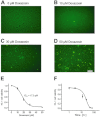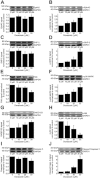Regulation of apoptosis in HL-1 cardiomyocytes by phosphorylation of the receptor tyrosine kinase EphA2 and protection by lithocholic acid
- PMID: 22845314
- PMCID: PMC3514767
- DOI: 10.1111/j.1476-5381.2012.02117.x
Regulation of apoptosis in HL-1 cardiomyocytes by phosphorylation of the receptor tyrosine kinase EphA2 and protection by lithocholic acid
Abstract
Background and purpose: Heart failure and atrial fibrillation are associated with apoptosis of cardiomyocytes, suggesting common abnormalities in pro-apoptotic cardiac molecules. Activation of the receptor tyrosine kinase EphA2 causes apoptosis in vitro, and dysregulation of EphA2-dependent signalling is implicated in LEOPARD and Noonan syndromes associated with cardiomyopathy. Molecular pathways and regulation of EphA2 signalling in the heart are poorly understood. Here we elucidated the pathways of EphA2-dependent apoptosis and evaluated a therapeutic strategy to prevent EphA2 activation and cardiac cell death.
Experimental approach: EphA2 signalling was studied in an established model of doxazosin-induced apoptosis in HL-1 cells. Apoptosis was measured with TUNEL assays and as cell viability using a formazan method. Western blotting and siRNA for EphA2 were also used.
Key results: Apoptosis induced by doxazosin (EC(50) = 17.3 μM) was associated with EphA2 activation through enhanced phosphorylation (2.2-fold). Activation of pro-apoptotic downstream factors, phospho-SHP-2 (3.9-fold), phospho-p38 MAPK (2.3-fold) and GADD153 (1.6-fold) resulted in cleavage of caspase 3. Furthermore, two anti-apoptotic enzymes were suppressed (focal adhesion kinase, by 41%; phospho-Akt, by 78%). Inactivation of EphA2 with appropriate siRNA mimicked pro-apoptotic effects of doxazosin. Finally, administration of lithocholic acid (LCA) protected against apoptosis by increasing EphA2 protein levels and decreasing EphA2 phosphorylation.
Conclusions and implications: EphA2 phosphorylation and activation of SHP-2 are critical steps in apoptosis. Reduction of EphA2 phosphorylation by LCA may represent a novel approach for future anti-apoptotic treatment of heart failure and atrial fibrillation.
© 2012 The Authors. British Journal of Pharmacology © 2012 The British Pharmacological Society.
Figures





Similar articles
-
Amino acid conjugates of lithocholic acid as antagonists of the EphA2 receptor.J Med Chem. 2013 Apr 11;56(7):2936-47. doi: 10.1021/jm301890k. Epub 2013 Mar 22. J Med Chem. 2013. PMID: 23489211 Free PMC article.
-
Doxazosin induces activation of GADD153 and cleavage of focal adhesion kinase in cardiomyocytes en route to apoptosis.Cardiovasc Res. 2006 Jul 1;71(1):118-28. doi: 10.1016/j.cardiores.2006.03.014. Epub 2006 Mar 24. Cardiovasc Res. 2006. PMID: 16631627
-
Potential role of EphrinA2 receptors in postconditioning induced cardioprotection in rats.Eur J Pharmacol. 2020 Sep 15;883:173231. doi: 10.1016/j.ejphar.2020.173231. Epub 2020 Jun 24. Eur J Pharmacol. 2020. PMID: 32589885
-
Lithocholic acid is an Eph-ephrin ligand interfering with Eph-kinase activation.PLoS One. 2011 Mar 30;6(3):e18128. doi: 10.1371/journal.pone.0018128. PLoS One. 2011. PMID: 21479221 Free PMC article.
-
Emerging and Diverse Functions of the EphA2 Noncanonical Pathway in Cancer Progression.Biol Pharm Bull. 2017;40(10):1616-1624. doi: 10.1248/bpb.b17-00446. Biol Pharm Bull. 2017. PMID: 28966234 Review.
Cited by
-
From dried bear bile to molecular investigation of differential effects of bile acids in ex vivo and in vitro models of myocardial dysfunction: Relevance for neuroinflammation.Brain Behav Immun Health. 2023 Aug 2;32:100674. doi: 10.1016/j.bbih.2023.100674. eCollection 2023 Oct. Brain Behav Immun Health. 2023. PMID: 37593199 Free PMC article. Review.
-
Ephrin-Eph signaling as a potential therapeutic target for the treatment of myocardial infarction.Med Hypotheses. 2013 Jun;80(6):738-44. doi: 10.1016/j.mehy.2013.02.024. Epub 2013 Apr 4. Med Hypotheses. 2013. PMID: 23562676 Free PMC article.
-
Amino acid conjugates of lithocholic acid as antagonists of the EphA2 receptor.J Med Chem. 2013 Apr 11;56(7):2936-47. doi: 10.1021/jm301890k. Epub 2013 Mar 22. J Med Chem. 2013. PMID: 23489211 Free PMC article.
-
The Relationship Between Atrial Fibrillation and Intestinal Flora With Its Metabolites.Front Cardiovasc Med. 2022 Jul 1;9:948755. doi: 10.3389/fcvm.2022.948755. eCollection 2022. Front Cardiovasc Med. 2022. PMID: 35845042 Free PMC article. Review.
-
Regulatory T-cells regulate neonatal heart regeneration by potentiating cardiomyocyte proliferation in a paracrine manner.Theranostics. 2019 Jun 9;9(15):4324-4341. doi: 10.7150/thno.32734. eCollection 2019. Theranostics. 2019. PMID: 31285764 Free PMC article.
References
-
- Aimé-Sempé C, Folliguet T, Rücker-Martin C, Krajewska M, Krajewska S, Heimburger M, et al. Myocardial cell death in fibrillating and dilated human right atria. J Am Coll Cardiol. 1999;34:1577–1586. - PubMed
-
- Bikou O, Thomas D, Trappe K, Lugenbiel P, Kelemen K, Koch M, et al. Connexin 43 gene therapy prevents persistent atrial fibrillation in a porcine model. Cardiovasc Res. 2011;92:218–225. - PubMed
-
- Cardin S, Li D, Thorin-Trescases N, Leung TK, Thorin E, Nattel S. Evolution of the atrial fibrillation substrate in experimental congestive heart failure: angiotensin-dependent and -independent pathways. Cardiovasc Res. 2003;60:315–325. - PubMed
Publication types
MeSH terms
Substances
LinkOut - more resources
Full Text Sources
Research Materials
Miscellaneous

